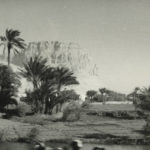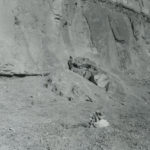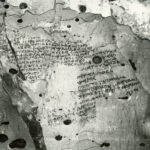ǦABAL AL-ṬĀRIF
| Arabic | نجع حمادي | جبل الطارف |
| English | Nag Hammadi | Jabal al-Tarif |
| French | Gebel el-Tarif | Gebel el-Ta'rif | Gebel et-Tarif | Guebel el-Tarif |
| DEChriM ID | 34 |
| Trismegistos GeoID | 2803 |
| Pleiades ID | - | PAThs ID | 83 |
| Ancient name | - |
| Modern name | Ǧabal al-Ṭārif |
| Latitude | 26.106154 |
| Longitude | 32.310994 |
| Date from | - |
| Date to | - |
| Typology | Uncertain |
| Dating criteria | - |
| Description | Ǧabal al-Ṭārif is a mountain situated on the right bank of the Nile, c. 11km to the north-east of the modern town of Naǧʿ Ḥammādī, in Upper Egypt. In the general area of the ǧabal, in what has been presumed to have been December 1945, a collection of Coptic codices was found, since named “The Nag Hammadi Library”. The codices were purportedly found by local resident Muḥammad ʿAlī al-Sammān while digging sebakh – who he was with at the time of the discovery, where the actual find-spot is, and the timeline of the codices immediately after their discovery, are all greatly contested matters (see: Goodacre 2013; Denzy Lewis and Blount 2014; Nongbri 2016). After coming onto the antiquities market, French archaeologist and papyrologist Jean Doresse set out on a ‘fact-finding’ mission in the area in January 1950, so as to locate the the find-spot, and understand more about the archaeological context from which the codices came. During this visit, Doresse identified the south-east flank of the Ǧabal al-Ṭārif as having been the location of the discovery, specifically “at the foot of the wall of rock”, as shown by the photograph (and accompanying caption) on the cover of his 1960 publication (Doresse 1960). Apparently, no locals were willing or able to provide supplementary information regarding the discovery (North 1962: 155 n. 6). The work of Doresse was followed by that of James M. Robinson in the late sixties, who attempted to develop upon the information obtained by Doresse. Robinson dedicated time to investigative research in the region, with most of the accepted information regarding the discovery coming from his work. Unfortunately, it seems that the investigative techniques employed and the interview etiquette were not particularly appropriate and would not hold up to modern-day anthropological protocols (Goodacre 2013: 312-315). The whole situation was complicated further by the interval between the time of discovery and Robinson’s work in the area, which came some thirty years later. Additionally, as a result of local interpersonal disputes, which are dramatically cemented in popular consciousness as a heart-eating blood feud, there was a great deal of apprehension on the part of Muḥammad ʿAlī and other residents to return to the find-spot, remaining instead in the vicinity of al-Qaṣr. Every informant seems to have provided conflictual information, with a great deal of hearsay and rumor involved. Consequently, details differ between Robinson’s own publications, with overt inconsistencies rendering much of the origin-story of the Naǧʿ Ḥammādī codices unreliable (see Goodacre 2013: 308 for a table regarding major discrepancies between Robinson’s accounts). These exaggerations become particularly evident when compared with Doresse’s modest 1958 account and the difficulties he claimed to have encountered when trying to obtain additional information from residents. Further doubts on his conclusions are being cast by Robinson’s own admittance that Muḥammad ʿAlī was not a particularly reliable individual (Robinson 1979: 213). Doresse’s own description cannot be considered wholly accurate either. He states that the area at the south-east flank of Ǧabal al-Ṭārif “marks the site of the ancient cemetery where the jar containing the manuscripts was buried” (Doresse 1960, caption to title image). However, the archaeological work conducted in 1975 found no trace of a cemetery in the area of the photograph. It is possible that Doresse was simply referring to the cave tombs as a cemetery area, however, and there are numerous accounts which identify the find-spot as having been in a tomb or a cave (Robinson 1979: 212). Doresse’s own conclusions are not entirely clear: “Was it in one of these tombs that the papyri were found? Certainly, one cannot, even if one searches very far around, see any other place – any ruin or sepulcher – from which they could have come” (Doresse 1960, caption to title image). However, Muḥammad ʿAlī adamantly stated in an interview in September of 1975 that it was not found in cave (Robinson 1979: 212). Despite this claim, Muḥammad did at one point state that the codices were retrieved from the Sixth Dynasty Tomb of Thauti, which was indeed a cave, which was subsequently excavated to the bedrock without any results. This identification was later retracted by Muḥammad, who said that he had made the statement out of fear (Van Elderen and Robinson 1976a: 72; Robinson 1979: 212). On another visit to the site, Muḥammad walked without hesitation to another area (visible in Doresse’s photo) which he claimed to have been the actual find-spot (Van Elderen and Robinson 1976a: 74). Muḥammad had claimed that the codices were found alongside a body (which he would have reburied), so the excavators were looking for traces of a burial/reburial (Van Elderen and Robinson 1976a: 73, 74; Robinson 1979: 213). Additionally, the jar in which the codices were said to have been located was supposedly smashed at the site, so traces of pottery were also being sought after. The area was excavated, but without any confirmatory evidence based on Muḥammad’s description. Nonetheless, local reports seemingly support Doresse’s identification of the south-eastern flank of Ǧabal al-Ṭārif as the find-spot, as most (or all) of the informants identified the same area as being the origin of the codices, despite not having visited to site since the initial discovery (Van Elderen and Robinson 1976a: 75). To what extent this is the result of leading questions by Robinson, however, is uncertain. Ǧabal al-Ṭārif is pierced by over 150 caves and ancient tombs, one of which dates to the Sixth Dynasty, while the rest seem to be from the first centuries AD. Some of these are supposed to have been occupied by hermits, with this likely the case for at least one of them, T8, which comprises a room-sized chapel and includes Coptic dipinti with opening lines of Psalms (Robinson 1979: 213; Coquin and Martin 1991: 1317). Based on coins found in this cave, its use seems to have extended as late as the seventh century (Robinson 1979: 213). This cave is the closest one to the boulder identified by Ḫalīfa (one of the people said to have been present at the discovery) to have been the location of the codices (Robinson 1979: 210, 213). Ḫalīfa passed this information on to ʿAbd al-Maǧīd Muḥammad Badārī, the guard for the Department of Antiquities at al-Qaṣr, who identified two distinct boulders on two different occasions, neither of which revealed anything (Van Elderen and Robinson 1976a: 73; Robinson 1979: 210). Additional supporting information regarding the occupation/use of the area by Christians is T65, which had large crosses painted on the north and east walls. Radiocarbon analysis of textiles obtained from T117 gave a fifth century date, indicating that the area was in use around the time the codices are thought to have been written (Van Elderen and Robinson 1976a: 76, 77; Van Elderen 1979: 226). |
| Archaeological research | The archaeological work that has been conducted at the site has been very limited, with the actual find-spot heavily contested (see: Goodacre 2013; Denzy Lewis and Blount 2014; Nongbri 2016). After having been supposedly discovered by Muḥammad ʿAlī al-Sammān, and perhaps one other (or nine) (Goodacre 2013: 303) in what is thought to have been December of 1945, the area was visited by French scholars Jean and Marianne Doresse in an attempt to find out more about the origin of the codices. This was followed by visits from a number of scholars including Søren Giversen, accompanied by Edward F. Wente from the Chicago House in Luxor in early 1958, Robert North in 1959, and Martin Krause in the early 1960s. However, none of these visits led to additional information pertaining to the origin and context of the find (Robinson 1979: 296-297). James M. Robinson visited March 3rd and April 23rd of 1966, with accessibility of the area soon limited as a result of the Six-Day War. Funding was obtained in 1969 from the Smithsonian Institution, through the American Research Center in Egypt (ARCE), for a three-year campaign to commence the following year. Eventually, thirty years after the discovery of the codices, excavations began in November 1975. The fieldwork was directed by Torgny Säve-Söderbergh (1975) and, in his absence, by Bastiaan Van Elderen (1975, 1976, 1977-78). The fieldwork included a proton-magnetometer and resistivity survey on a section of the area where the codices were supposedly found, conducted by Philip Hammond of the University of Utah on the 10th-18th September 1975. Additionally, a number of test trenches were dug in the flat area in front of the talus in order to clarify Doresse’s claim that the sector was a cemetery. However, no trace of graves were found (Van Elderen and Robinson 1976a: 71-72). The fieldwork also saw the excavation of six of the 150 caves, and radiocarbon analysis of textiles, which were dated to the fifth century (Van Elderen 1979: 225-226). This was the first of three excavation seasons in the area conducted by the team. The second and third season were dedicated almost exclusively to Fāw al-Qiblī (Pboou) in order to clarify the supposed Pachomian origin of the codices (Van Elderen and Robinson 1976a: 79). The last ten days of the second season, however, were also dedicated to the continuation of the clearing of a number of tombs in Ǧabal al-Ṭārif, particularly the Sixth-Dynasty tomb of Thauti (Van Elderen and Robinson 1977a: 68). Additionally, a general survey of al-Qaṣr (ancient Chenoboskeia) was conducted, as well as a survey of the wādī-s to the north of al-Qaṣr and Ǧabal al-Ṭārif, where some of the Bodmer papyri were hypothesised to have been found (Van Elderen and Robinson 1977a: 57, 70). Prior to the work of the ARCE, illicit excavations were said to have occurred conducted by Abū Hindāwī, the mayor of Ḥamra Dūm. When these ‘excavations’ began is not known, but they supposedly ceased three years prior to the work of ARCE (1972) when Abū Hindāwī died (Van Elderen 1976a: 74). |
• Bucher, P. 1931. "Les commencements des Psaumes LI à XCIII: inscription d’une tombe de ?a?r e?-?aijad." Kemi 4: 157-160.
• Coquin, R. -G. and M. Martin. 1991. "Jabal al-Ṭārif." In The Coptic Encyclopedia vol. 4, edited by A. S. Atiya, 1317. New York: Macmillan Publishing Company.
• Denzey Lewis, N. and J. A. Blount. 2014. “Rethinking the Origins of the Nag Hammadi Codices.” Journal of Biblical Literature 133, 2: 399-419.
• Doresse, J. 1950a. “A Gnostic Library from Upper Egypt.” Archaeology 3: 69-73.
• Doresse, J. 1950b. “Sur le traces des papyrus gnostiques: Recherches à Chénoboskion.” Bulletin de l’Académie royale de Belgique 36: 432-439.
• Doresse, J. 1958. Les livres secrets des gnostiques d’Égypte: Introduction aux écrits gnostiques coptes découverts à Khénoboskion. Paris: Librairie Plon.
• Doresse, J. 1960. The Secret Books of the Egyptian Gnostics: An Introduction to the Gnostic Coptic Manuscripts Discovered at Chenoboskion. New York: Viking Press.
• Emmel, S. 1991. “The Nag Hammadi Library.” In The Coptic Encyclopedia, vol. VI, edited by A. S. Atiya, 1771-1773. New York: Macmillan Publishing Company
• Goehring, J. E. 1984. “Byzantine Coins from the Jabal al-Tarif in Upper Egypt.” Bulletin de la Société d’archéologie copte 26: 31-40.
• Goodacre, M. 2013. “How Reliable is the Story of the Nag Hammadi Discovery?” Journal for the Study of the New Testament 35: 303-322.
• Lundhaug, H. and L. Jenott. 2015. The Monastic Origins of the Nag Hammadi Codices. Tübingen: Mohr Siebeck.
• Mina, T. 1948. “Le papyrus gnostique du Musée Copte.” Vigiliae Christianae 2: 129–136.
• Nongbri, B. 2016. “Finding Early Christian Books at Nag Hammadi and Beyond.” Bulletin for the Study of Religion 45, 2: 11-19.
• North, R. 1962. “Chenoboskion and Q.” Catholic Biblical Quarterly 24, 2: 154-170.
• Puech, H.-C. 1950. “Les nouveaux écrits gnostiques découverts en Haute-Égypte (premier inventaire et essaie d’identification).” In Coptic Studies in Honor of Walter Ewing Crum, 91-154. Boston: The Byzantine Institute.
• Robinson, J. M. 1976. “The First Season of the Nag Hammadi Excavation, 27 November-19 December 1975.” Göttinger Misz 22: 71-79.
• Robinson, J. M, ed. 1977. The Nag Hammadi Library in English. Leiden: Brill.
• Robinson, J. M. 1979. “The Discovery of the Nag Hammadi Codices.” The Biblical Archaeologist 42, 4: 206-224.
• Robinson, J. M. 1981. “From Cliff to Cairo. Story of the Discovers and the Middlemen of the Nag Hammadi Codices.” In Colloque international sur les textes de Nag Hammadi: Qebec, 22-25 août 1978, edited by B. Barc, 21-58. Quebec: Presses de l’Université Laval.
• Robinson, J. M. 1986. “The Discovering and Marketing of Coptic Manuscripts. The Nag Hammadi Codices and the Bodmer Papyri.” In The Roots of Egyptian Christianity, edited by B. A. Pearson and J. E. Goehring, 2-25. Philadelphia: Fortress Press.
• Robinson, J. M. 1988. The Nag Hammadi Library in English, 3rd Review ed. Leiden: Brill.
• Robinson, J. M. 2009. “The Discovery of the Nag Hammadi Codices.” Journal of Coptic Studies 11: 1-21.
• Robinson, J. M. 2014. The Nag Hammadi Story, 2 vols. Leiden: Brill.
• Van Elderen, B. 1979. “The Nag Hammadi Excavation.” Biblical Archaeology 42: 225-231.
• Van Elderen, B. and J. M. Robinson 1976a. The First Season of the Nag Hammadi Excavation 27 November-19 December 1975.” Göttingen Miszellen 22: 71-79
• Van Elderen, B. and J. M. Robinson 1976b. “The First Season of the Nag Hammadi Excavation 27 November-19 December 1975.” American Research Center in Egypt Newsletter 96: 18-24
• Van Elderen, B., and J. M. Robinson. 1977a. “The Second Season of the Nag Hammadi Excavation 22 November-29 December 1976.” Göttingen Miszellen 24: 57-73.
• Van Elderen, B., and J. M. Robinson. 1977b. “The Second Season of the Nag Hammadi Excavation 22 November-29 December 1976.” American Research Center in Egypt Newsletter 99/100: 36-54.


 Json data
Json data








